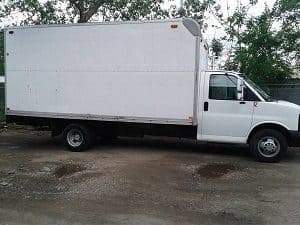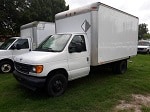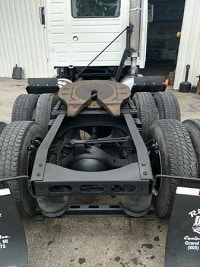 What is a straight truck? A straight truck has a single frame that extends from the front to the rear of the truck and the axles are attached to the frame. The cargo area/container is also attached to the frame. A straight truck is also referred to as a Box Truck, a Cube Truck, a Rolling Toaster, and a Cube Van.
What is a straight truck? A straight truck has a single frame that extends from the front to the rear of the truck and the axles are attached to the frame. The cargo area/container is also attached to the frame. A straight truck is also referred to as a Box Truck, a Cube Truck, a Rolling Toaster, and a Cube Van.
Straight trucks are often used to haul furniture, boxes, refrigerators, and washers and dryers.
The door in the back on the straight truck resembles and operates similar to a overhead garage door.
A straight truck can vary in length. Many people usually rent a straight truck when they are moving.
U-Haul and Ryder are a couple of well-known businesses that rent out straight trucks in different sizes.
What Does A Straight Truck Look Like?
A straight truck looks like the one in this picture, notice the cargo box is attached to the frame and the frame extends from the front to the rear of the truck.

The straight truck has a cuboid shape for the cargo, which is why a straight truck has numerous names such as a Rolling Toaster and Box Truck.
Notice it has a solid frame extending from the front of the vehicle to the rear of it.
Straight Truck vs. Tractor Trailer (the difference)
What is the difference between a straight truck versus a tractor trailer truck?
There are many differences between these two types of trucks.
The most recognizable difference is the way they look.
Take a look at the two pictures below of a straight truck and a tractor trailer.
The trailer of the tractor trailer can be removed while the straight truck does not have a trailer that can be removed. The straight truck has a container/cube that is attached to the frame of the truck.


Straight Truck
A straight truck has a rectangular shape. The rectangular box is separated from the cab of the truck. A straight truck has many features, which include:
• Maximum weight total : Usually up to 33,000 lbs. but vary based on size of straight truck.
• Does not have a fifth wheel.
• Maximum height: 14 feet (usually)
• Less costs to operate than a tractor trailer
• Able to stop frequently with no issues
Tractor Trailer (not a straight truck)
A tractor trailer is a tractor truck with a trailer that is not attached to the frame of the truck.
The trailer doesn’t have a front axle, and most of the weight in the trailer is held up with the tractor or with a dolly, which is a front axle that is detachable.
A tractor trailer is also known as a semi-truck, a big-rig, and an 18-wheeler.
There are many different features that a tractor trailer has, which include:
• Maximum weight total: 80,000 pounds (Special permits required for extended lengths and widths)
• Does have a fifth wheel
• Maximum height: 13 feet and 6 inches
• Higher costs to operate over a straight truck
• Often have bunk space for OTR (long haul) drivers to live in.
The most common trailer sizes are 53 foot or 48 foot in length and in width it is 102 inches or 96 inches.
The trailer can be attached to the tractor with two different connecting devices that are called the fifth wheel and the kingpin.

If the trailer is connected to the tractor using the fifth-wheel, then there is a fifth wheel plate that is attached to the frame of the tractor.
The fifth wheel has a spring lock and jaw that keeps the trailer connected.
The kingpin is at the end of the front of the trailer, and it is a cylindrical pin made of extremely heavy metal.
The metal plate lets the fifth wheel easily slide beneath the trailer, then it will lock to the kingpin on the trailer.
The two together allows the trailer to make turns easier and there is added stability and security when driving on the highways.
Once the driver is ready to disconnect the trailer from the tractor, the driver will just have to pull the lever, and the fifth wheel will disengage so the driver can move the tractor safely from the trailer.
Straight Truck Pros
• Easy to drive and maneuver
• Low operational costs
• Loads are usually local
• Often the driver does not need a CDL. This can get confusing though, I recommend you check out this article that I wrote explaining who needs a CDL and who doesn’t.
Tractor Trailer Pros
• Flexibility
• Less maintenance
• More revenue
• More load options
• Can haul more freight and heavier freight (a Class A CDL is required, find out all about the differences between a Class A CDL and Class B CDL in my other article here).
Is A Straight Truck A Box Truck?
Yes, a straight truck is a box truck.
A straight truck/box truck means that the cab and the bed are on the same frame together.
They also have a standard roll-up cargo door that is similar to a garage door.
Some of the straight/box truck come with a hydraulic lift or a pull-out ramp, which is standard.
The straight/box truck can range from ten feet through twenty-six feet long.
The smaller straight/box trucks are approximately six feet tall and they can also go up to being over eight feet tall too.
The standard straight/box truck weight limit can range from 12,500 pounds up to 33,000 pounds. This is called the Gross Vehicle Weight Rating or GVWR.
Usually, a straight/box truck is used for local work, and rarely used for long over-the-road hauls.
This type of truck is easier to drive, and the most common freight is furniture, appliances, and other local needs such as small, local businesses.
What Else Is A Straight Truck Called?
A straight truck has numerous names that it is known as. They include:
• Box truck
• Cube truck
• Rolling Toaster
• Cube van
How Long Is A Straight Truck?
A straight truck varies in length.
A straight truck can start off at ten feet through twenty-six feet long.
Smaller straight trucks are approximately six feet tall, and the larger straight trucks are approximately eight feet tall, which makes the straight truck easier to maneuver when driving.
Is A Pickup Truck A Straight Truck?
A popular question that many people are asking is, “Is a pickup truck a straight truck”?
This question can have a yes and no answer.
The pickup truck has to be twenty-six feet or less in length. Most pickup trucks don’t have a box enclosure for their bed, but it depends entirely on your personal pickup truck.
There are some pickup trucks that are considered a commercial vehicle.
If the pickup truck is below the GVWR (Gross Vehicle Weight Rating) 10,001 pounds, then the pickup truck isn’t considered a commercial vehicle.
If you are driving a pickup truck with weight/freight that exceeds 10,001 pounds it would be considered a commercial vehicle.
All pickup trucks state their GVWR when you open the driver’s door and look at the manufacture’s sticker.
The GVWR is the Gross Vehicle Weight Rating, this is the amount of freight the axles of the truck are able to carry.
This amount should not be exceeded for safety reasons and the driver can be ticketed with a violation.
Is A Dump Truck Considered A Straight Truck?
A dump truck could be considered a straight truck, because the cargo area can be enclosed and on the rear of the cargo area is where the load can be released out.
A dump truck is rarely called a straight truck though.
A truck must have a cab and body that is combined to make one component can be considered a straight truck.
The truck must also be twenty-six foot or less in length.
A dump truck almost always will require at least a Class B CDL in order to drive one because they typically have a GVWR of 26,001 pounds or more.
Do You Need A CDL To Drive A Straight Truck?
You will need a CDL (Commercial Driver’s License) to drive a straight truck if the GVWR is 26,001 pounds or more.
By the way, most straight trucks have a GVWR this is below 26,001 pounds. This means you usually don’t need a CDL to drive one.
Anyone that wants to drive a vehicle that has a GVWR 26,001 and more pounds will need to get a Class B CDL license.
With a class B CDL you can drive these vehicles:
• Straight and Box Trucks
• Large Busses
• Dump Trucks with a trailer
Remember, it isn’t required to have a CDL if your straight truck has less than GVWR 26,001 pounds.
This topic of GVWR can be rather confusing, that is why I recommend you take a look at my other article to find out.
Why Are Straight Trucks So Popular?
Straight trucks are becoming more popular with many companies.
Potential truck drivers can become a professional truck driver without having to get a Class A CDL.
Driving a straight truck comes with many benefits for truck drivers, which include:
• Home Daily – Drivers who drive a straight truck are usually home daily. This is ideal for drivers who don’t want to away from home for weeks.
• No CDL Needed – Depending on the type of straight truck, drivers won’t need to get a CDL. Some of the straight truck jobs only require drivers to obtain a Class B.
To find out the difference between the Class A and Class B CDL you need to see my explanation here.
• Productive Work Environment – Straight truck drivers will have a productive work environment as they will usually have the same customers and clients that they see weekly.
Interacting with customers makes the job not so isolated for drivers.
• Benefits – Many straight truck jobs offer their drivers an hourly pay, which is very beneficial for drivers.
Most truck drivers get paid by the mile, so when they are broke down or stuck in traffic, they are not making any money, but a straight truck driver is getting paid by the hour no matter what occurs.
They also have other benefits, which include medical and life insurance, bonuses, and 401k plans.
• Good Wages – A straight truck driver can earn up to $50,000 per year, depending on the company.
If you are interested in becoming a truck driver, then you may want to start out driving a straight truck, because they are easier to maneuver and you won’t be required to get a CDL.
Get started now by taking a look at some unique truck driving jobs in your area right here on my job board.